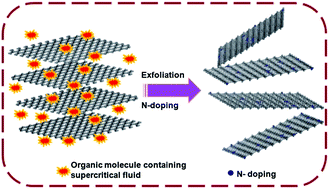Supercritical fluid assisted synthesis of N-doped graphene nanosheets and their capacitance behavior in ionic liquid and aqueous electrolytes†
Abstract
N-doped graphene nanosheets (N-doped GNS) were obtained by a single step supercritical fluid assisted reaction of N-containing organic compounds with graphene oxide (GO) solution. A N-doped GNS sample shows capacitances of 280 F g−1 in aqueous 1 M H2SO4 (0.9 V) and 104 F g−1 in ionic liquid EMI-TFSA (3.6 V). A NE-GNS electrode shows energy densities of 8 W h kg−1 and 40 W h kg−1 in 1 M H2SO4 and EMI-TFSA, respectively. The nature of chemical bonding and the amount of N doping in the graphene samples were estimated by XPS spectroscopy. The amount of N-doping varies with the nature of the N-containing organic compounds and the supercapacitance behaviour depends on the amount of N-doping as well as the nature of N-doping in the graphene. TEM, FE-SEM images and Raman spectroscopic characterization reveals the presence of few-layer N-doped GNS. FT-IR spectra exhibit the presence of various functional groups on N-doped GNS. XRD diffraction analysis showed the weakly stacked N-doped GNS due to the N-doping and the presence of N-containing functional groups on N-doped GNS. The cyclic voltammetry studies showed the capacitance behaviour of N-doped GNS electrodes at a high potential window of 4.25 V in ionic liquids. The charge–discharge profile showed the stable charge–discharge behaviour of the N-doped GNS electrodes.


 Please wait while we load your content...
Please wait while we load your content...